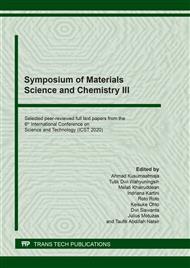[1]
A.E. Atabani, A.S. Silitonga, H.C. Ong, T.M.I. Mahlia, H.H. Masjuki, I.A. Badruddin, H. Fayaz, Non-Edible Vegetable Oils: A Critical Evaluation of Oil Extraction, Fatty Acid Compositions, Biodiesel Production, Characteristics, Engine Performance, and Emissions Production. Renew. Sust. Energ. Rev., 18 (2013) 211-245.
DOI: 10.1016/j.rser.2012.10.013
Google Scholar
[2]
S.K. Kim, S. Brand, H. Lee, Y. Kim, J. Kim, Production of Renewable Diesel by Hydrotreatment of Soybean Oil: Effect of Reaction Parameters. Chem. Eng. J. 228 (2013) 114-123.
DOI: 10.1016/j.cej.2013.04.095
Google Scholar
[3]
E. Furimsky, Hydroprocessing Challenges in Biofuels Production. Catal. Today 217 (2013) 13-56.
DOI: 10.1016/j.cattod.2012.11.008
Google Scholar
[4]
J.K. Satyarthi, D. Srinivas, Fourier Transform Infrared Spectroscopic Method for Monitoring Hydroprocessing of Vegetable Oils to Produce Hydrocarbon-Based Biofuel. Energ. Fuel. 25 (2011) 3318-3322.
DOI: 10.1021/ef200722q
Google Scholar
[5]
H. Zhang, H. Lin, Y. Zheng, The Role of Cobalt and Nickel in Deoxygenation of Vegetable Oils. Appl. Catal. B: Env. 160 (2014) 415-422.
DOI: 10.1016/j.apcatb.2014.05.043
Google Scholar
[6]
A. Ishihara, N. Fukui, H. Nasu, T. Hashimoto, Hydrocracking of Soybean Oil using Zeolite-Alumina Composite Supported NiMo. Catal. Fuel 134 (2014) 611-617.
DOI: 10.1016/j.fuel.2014.06.004
Google Scholar
[7]
V.T. da Silva, L.A. Sousa, Catalytic Upgrading of Fats and Vegetable Oils for the Production of Fuels, Chapter 3. The Role of Catalysis for the Sustainable Production of Bio-fuels and Bio-Chemicals: Elsevier B.V. (2013).
DOI: 10.1016/b978-0-444-56330-9.00003-6
Google Scholar
[8]
B. Veriansyah, J.Y. Han, S.K. Kim, S. Hong, Y.J. Kim, J.S. Lim, Y.W. Shu, S. Oh, J. Kim, Production of Renewable Diesel by Hydroprocessing of Soybean Oil: Effect. Fuel 94 (2012) 578-585.
DOI: 10.1016/j.fuel.2011.10.057
Google Scholar
[9]
M.D. Romero, J.A. Calles, A.Rodrıguez, J.C. Cabanelas, The Influence of Calcination Treatment over Bifunctional Ni/HZSM-5 Catalysts. Ind. Eng. Chem. Res. 37 (1998) 3846-3852.
DOI: 10.1021/ie980143i
Google Scholar
[10]
H. Martinez-Grimaldo, H. Ortiz-Moreno, F. Sanchez-Minero, J. Ramirez, R. Cuevas-Garcia, J. Ancheyta-Juarez, Hydrocracking of Maya Crude Oil in Slurry- Phase Reactor. I. Effect of Reaction Temperature. Catal. Today 220 (2014) 295-300.
DOI: 10.1016/j.cattod.2013.08.012
Google Scholar
[11]
X. Zheng, J. Chang, Y. Fu, One-pot Catalytic Hydrocracking of Diesel Distillate and Residual Oil Fractions Obtained from Bio-Oil to Gasoline-Range Hydrocarbon Fuel. Fuel 157 (2015) 107-114.
DOI: 10.1016/j.fuel.2015.05.002
Google Scholar
[12]
M. Rabaev, M.V. Landau, R. Vidruk-Nehemya, V. Koukouliev, R. Zarchin, M. Herskowitz, Conversion of Vegetable Oils on Pt/Al2O3/SAPO-11 to Diesel and Jet Fuels Containing Aromatics. Fuel 161 (2015) 287-294.
DOI: 10.1016/j.fuel.2015.08.063
Google Scholar
[13]
Y.R. Noor, M. Khazali, I.N.N. Suryadiputra, Panduan Pengenalan Mangrove di Indonesia. PHKA/WI-IP, Bogor (1999).
Google Scholar
[14]
D. Endriana, Sintesis Biodiesel (Metil ester) dari Minyak Biji Bintaro (Cerbera Odollam Gaertn) hasil ekstraksi. Kimia MIPA-UI, Universitas Indonesia, Jakarta (2007).
DOI: 10.24252/al-kimia.v4i1.1453
Google Scholar
[15]
Irwanto, Keanekaragaman Fauna pada Habitat Mangrove, Makalah, Yogyakarta (2006).
Google Scholar
[16]
Y.A. Purwanto, B.I. Setiawan, K. Sunandar, Pengembangan Tanaman Bintaro untuk Pemenuhan Bioenergi sebagai Kegiatan Tanaman Kehidupan HTI, Palembang (2011).
Google Scholar
[17]
S. Vichaphund, Production of aromatic compounds from catalytic fast pyrolysis of Jatropha residues using metal/HZSM-5 prepared by ion-exchange and impregnation methods, Renew. Energ. 79 (2015) 28–37.
DOI: 10.1016/j.renene.2014.10.013
Google Scholar
[18]
M. Al-Muttaqii, F. Kurniawansyah, D.H. Prajitno, A. Roesyadi, Bio-kerosene and Bio-gasoil from Coconut Oils via Hydrocracking Process over NiFe/HZSM-5 Catalyst, Bull. Chem. React. Eng. Catal. 14(2) (2019) 309.
DOI: 10.9767/bcrec.14.2.2669.309-319
Google Scholar
[19]
L. Marlinda, M. Al-Muttaqii, A. Roesyadi, Formation of hydrocarbon compounds during the hydrocracking of non-edible vegetable oils with cobalt-nickel supported on hierarchical HZSM-5 catalyst, IOP Conference Series: Earth and Environmental Science. IOP Publ. 67 (2017).
DOI: 10.1088/1755-1315/67/1/012022
Google Scholar
[20]
S. Sartipi, M. Alberts, M.J. Meijerink, T.C. Keller, J, Pérez-Ramírez, J. Gascon, F. Kapteijn, Towards Liquid Fuels from Biosyngas: Effect of Zeolite Structure in Hierarchical-Zeolite-Supported Cobalt Catalysts. Chem. Sus. Chem. 6 (2013) 1646–1650.
DOI: 10.1002/cssc.201300339
Google Scholar


